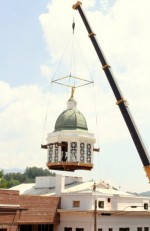
On June 29, the cupola on top of the old Jackson County Courthouse was removed from its perch to undergo repairs for the second time since it was first built in 1913. Only a few years before its centennial, the courthouse, which is the most photographed building in Western North Carolina, is undergoing repairs and restorations from water damage to prepare for its transformation from a 1900’s courthouse and jail to a state of the art library facility for the county. The removal of the cupola only adds another event to the courthouses’ nearly 100 years of history.
Jackson County was formed in 1852 by taking parts of Haywood and Macon counties. It was named after President Andrew Jackson. The first Jackson County courthouse was a brick building on the bank of the Tuckaseigee River just west of the Love Farm. This courthouse was used until 1913 when the county seat was moved from Webster to Sylva. The new courthouse and jail was finished in 1914 on what used to be a hillside and central point of Sylva. Offices became occupied in February of 1914 and on March 2, 1914 Sylva was officially pronounced the new county seat and the courthouse was open for business. Former North Carolina governor Judge John W. Ellis presided over the first session of court. The distinctive dome of the courthouse and 107 steps leading from Main Street to the front doors was modeled after a courthouse that had been built in Madison County shortly before Sylva won the county seat.
On September 18, 1915, a ceremony was held to dedicate the Civil War monument which honors surviving veterans of the Civil War, which stands proud on the steps leading from Main Street to the courthouse. There was reportedly a crowd of 3,000 people in attendance for the ceremony; the size of the gathering was possible in large part because of the railway passenger service being constructed and improved in Jackson County at the time. The September 24 issue of the Sylva newspaper at the time, The Jackson County Journal, reported, “The whole order of the day was surcharged with interest and thrill from the beginning to end. Early in the forenoon the crowds began to gather and the streets of the little ‘gem of the mountains’ were alive and astir. Every train brought crowded coaches, and long processions of wagons, buggies, carriages and automobiles, flanked and re-inforced by riders on horseback, could be seen converging upon the capital city of the county.”
By the time of the dedication ceremony, Civil War veterans were diminishing and World War I had been devastating Europe for over a year and it was only a short time before America would become involved. The monument’s placement on the courthouse steps as well as Sylva being recognized as the county seat was intended to inspire economic growth and prosperity for the future of Jackson County as well as America. In 1979 the Jackson County courthouse was listed on the National Register of Historic Places, which secured its foundation and ensured its permanent belonging on top of the hill. The courthouse remained in use until August of 1994 when the new Jackson County Justice and Administration Building was finished.
The recent restoration isn’t the first repairs the old courthouse has seen. Extensive restoration was done in 1995 by the same company conducting the repairs today. Al Moore of Charlotte works for Superior Crane Charlotte District Operations, the company overseeing the repairs on the old courthouse cupola. He was in Sylva in 1994 and operated the vary crane who removed it the first time.
Once the cupola dome is replaced on top of the courthouse, construction will continue to transform the historic courthouse into a public library that is expected to be ready in December of this year. The new library will mainly be housed in a two-story addition being constructed behind the old courthouse, where the original county jail once stood. The two buildings will be connected by a two-story atrium that will serve as an entrance way into the library. The original 6,000 square foot space inside the old courthouse will be renovated and dedicated to meeting space and conference rooms for the community.
The renovations to the courthouse are only adding to the unique and interesting history of the building and to Jackson County. The structure being added to the back of the old courthouse is promised not to alter the priceless, historic, view that can be seen from the front steps of the old courthouse.







